Utilizing Peer-to-Peer Learning to Enhance Student Performance
VerifiedAdded on 2020/03/16
|9
|2348
|51
Report
AI Summary
This report comprehensively examines the concept of peer-to-peer learning, highlighting its potential to enhance student performance, confidence, and independence. It begins with an executive summary outlining the importance of peer learning and the need to maximize its benefits, addressing historical misconceptions that emphasized competition over cooperation. The introduction defines peer-to-peer learning and emphasizes its interactive nature, detailing how students can leverage each other's strengths to improve learning and problem-solving skills. The report explores various opportunities presented by this model, including increased safety, improved learning experiences, and the development of healthy competition among students. It also addresses challenges, such as lack of confidence and negative group interactions, providing solutions to improve the overall peer-to-peer experience. The report draws on case examples and research findings to illustrate the practical application and effectiveness of peer-to-peer learning. Finally, it offers recommendations for improvement, such as allowing students to choose their partners, promoting professionalism, addressing negative competition, and integrating peer learning into library resources. The report emphasizes the untapped potential of peer-to-peer learning and its ability to transform educational standards and promote student independence.
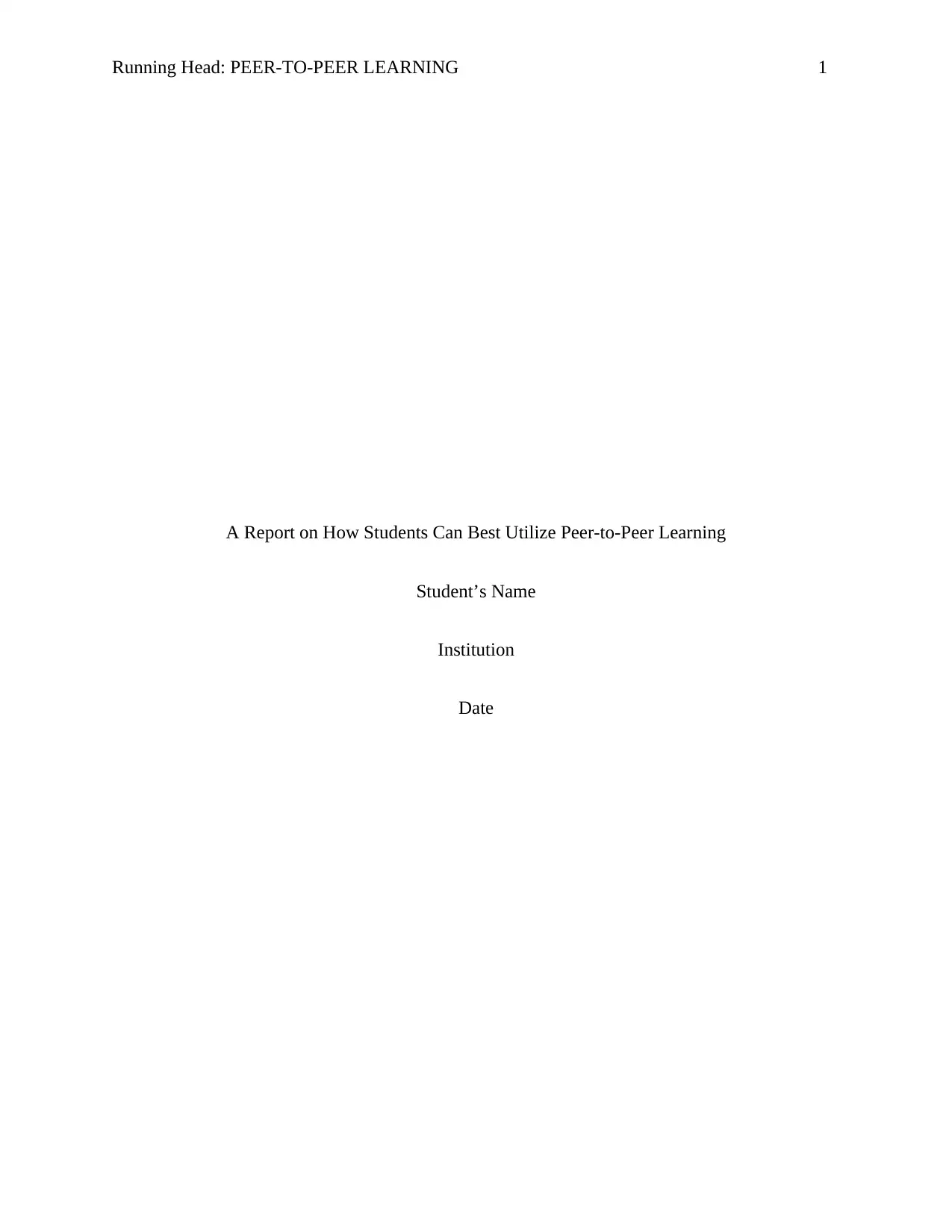
Running Head: PEER-TO-PEER LEARNING 1
A Report on How Students Can Best Utilize Peer-to-Peer Learning
Student’s Name
Institution
Date
A Report on How Students Can Best Utilize Peer-to-Peer Learning
Student’s Name
Institution
Date
Paraphrase This Document
Need a fresh take? Get an instant paraphrase of this document with our AI Paraphraser
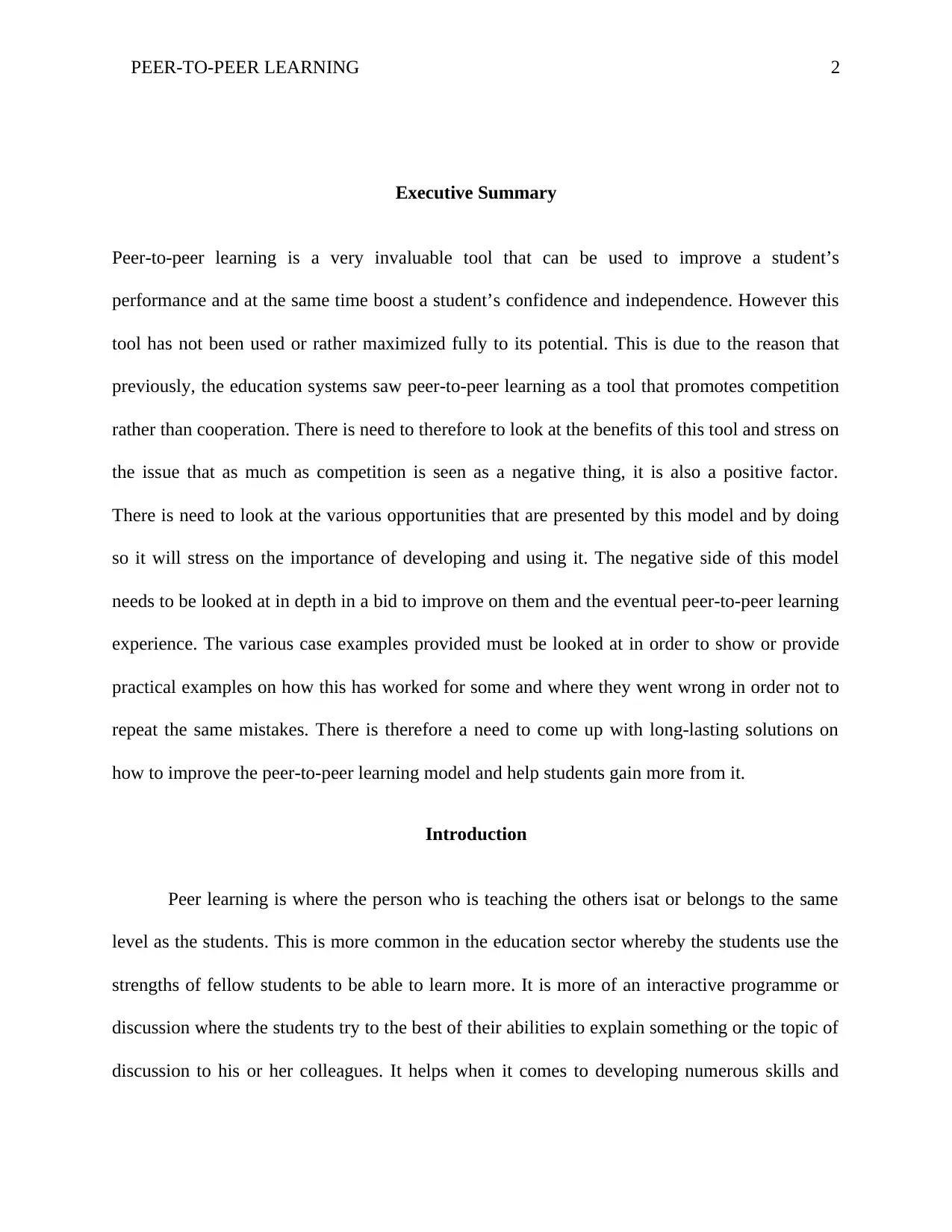
PEER-TO-PEER LEARNING 2
Executive Summary
Peer-to-peer learning is a very invaluable tool that can be used to improve a student’s
performance and at the same time boost a student’s confidence and independence. However this
tool has not been used or rather maximized fully to its potential. This is due to the reason that
previously, the education systems saw peer-to-peer learning as a tool that promotes competition
rather than cooperation. There is need to therefore to look at the benefits of this tool and stress on
the issue that as much as competition is seen as a negative thing, it is also a positive factor.
There is need to look at the various opportunities that are presented by this model and by doing
so it will stress on the importance of developing and using it. The negative side of this model
needs to be looked at in depth in a bid to improve on them and the eventual peer-to-peer learning
experience. The various case examples provided must be looked at in order to show or provide
practical examples on how this has worked for some and where they went wrong in order not to
repeat the same mistakes. There is therefore a need to come up with long-lasting solutions on
how to improve the peer-to-peer learning model and help students gain more from it.
Introduction
Peer learning is where the person who is teaching the others isat or belongs to the same
level as the students. This is more common in the education sector whereby the students use the
strengths of fellow students to be able to learn more. It is more of an interactive programme or
discussion where the students try to the best of their abilities to explain something or the topic of
discussion to his or her colleagues. It helps when it comes to developing numerous skills and
Executive Summary
Peer-to-peer learning is a very invaluable tool that can be used to improve a student’s
performance and at the same time boost a student’s confidence and independence. However this
tool has not been used or rather maximized fully to its potential. This is due to the reason that
previously, the education systems saw peer-to-peer learning as a tool that promotes competition
rather than cooperation. There is need to therefore to look at the benefits of this tool and stress on
the issue that as much as competition is seen as a negative thing, it is also a positive factor.
There is need to look at the various opportunities that are presented by this model and by doing
so it will stress on the importance of developing and using it. The negative side of this model
needs to be looked at in depth in a bid to improve on them and the eventual peer-to-peer learning
experience. The various case examples provided must be looked at in order to show or provide
practical examples on how this has worked for some and where they went wrong in order not to
repeat the same mistakes. There is therefore a need to come up with long-lasting solutions on
how to improve the peer-to-peer learning model and help students gain more from it.
Introduction
Peer learning is where the person who is teaching the others isat or belongs to the same
level as the students. This is more common in the education sector whereby the students use the
strengths of fellow students to be able to learn more. It is more of an interactive programme or
discussion where the students try to the best of their abilities to explain something or the topic of
discussion to his or her colleagues. It helps when it comes to developing numerous skills and
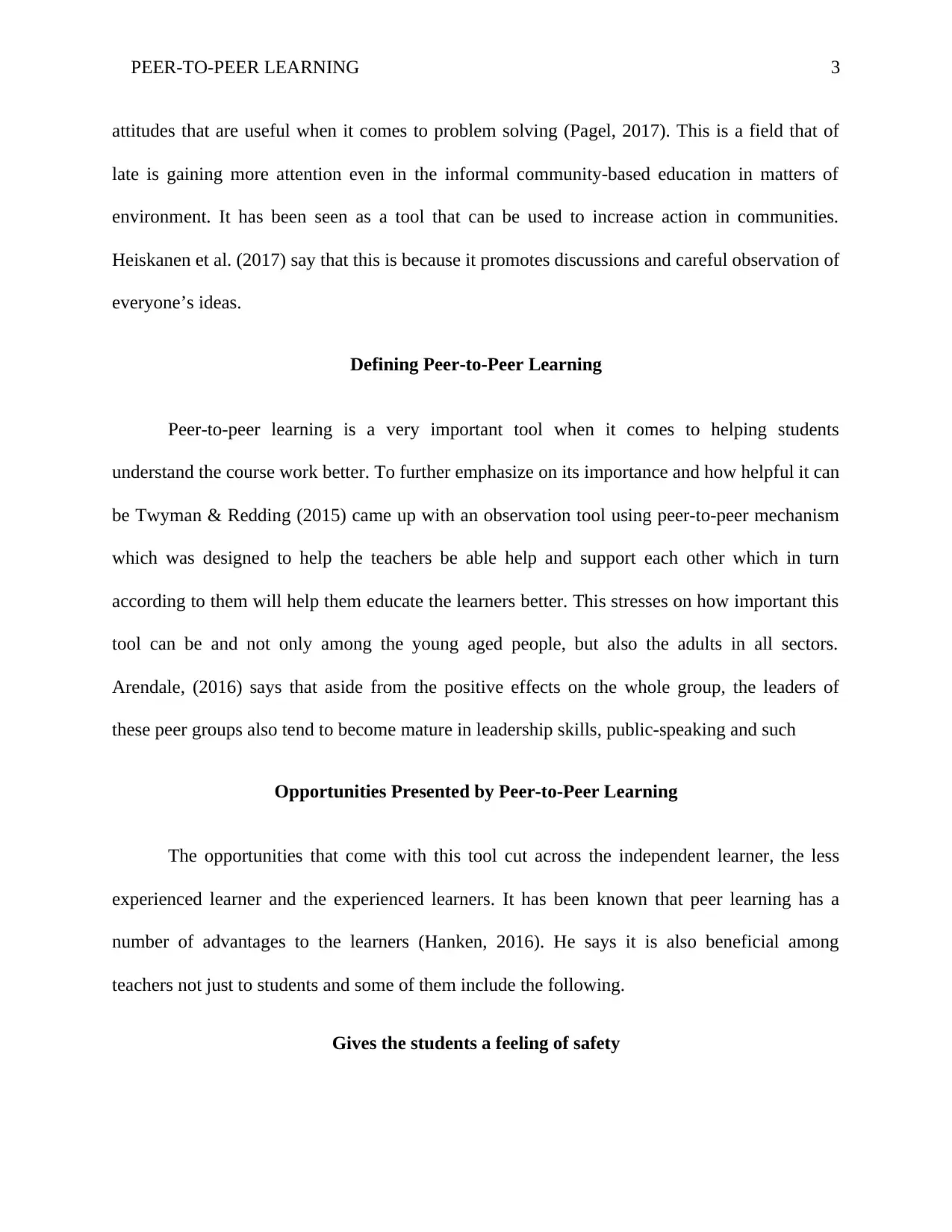
PEER-TO-PEER LEARNING 3
attitudes that are useful when it comes to problem solving (Pagel, 2017). This is a field that of
late is gaining more attention even in the informal community-based education in matters of
environment. It has been seen as a tool that can be used to increase action in communities.
Heiskanen et al. (2017) say that this is because it promotes discussions and careful observation of
everyone’s ideas.
Defining Peer-to-Peer Learning
Peer-to-peer learning is a very important tool when it comes to helping students
understand the course work better. To further emphasize on its importance and how helpful it can
be Twyman & Redding (2015) came up with an observation tool using peer-to-peer mechanism
which was designed to help the teachers be able help and support each other which in turn
according to them will help them educate the learners better. This stresses on how important this
tool can be and not only among the young aged people, but also the adults in all sectors.
Arendale, (2016) says that aside from the positive effects on the whole group, the leaders of
these peer groups also tend to become mature in leadership skills, public-speaking and such
Opportunities Presented by Peer-to-Peer Learning
The opportunities that come with this tool cut across the independent learner, the less
experienced learner and the experienced learners. It has been known that peer learning has a
number of advantages to the learners (Hanken, 2016). He says it is also beneficial among
teachers not just to students and some of them include the following.
Gives the students a feeling of safety
attitudes that are useful when it comes to problem solving (Pagel, 2017). This is a field that of
late is gaining more attention even in the informal community-based education in matters of
environment. It has been seen as a tool that can be used to increase action in communities.
Heiskanen et al. (2017) say that this is because it promotes discussions and careful observation of
everyone’s ideas.
Defining Peer-to-Peer Learning
Peer-to-peer learning is a very important tool when it comes to helping students
understand the course work better. To further emphasize on its importance and how helpful it can
be Twyman & Redding (2015) came up with an observation tool using peer-to-peer mechanism
which was designed to help the teachers be able help and support each other which in turn
according to them will help them educate the learners better. This stresses on how important this
tool can be and not only among the young aged people, but also the adults in all sectors.
Arendale, (2016) says that aside from the positive effects on the whole group, the leaders of
these peer groups also tend to become mature in leadership skills, public-speaking and such
Opportunities Presented by Peer-to-Peer Learning
The opportunities that come with this tool cut across the independent learner, the less
experienced learner and the experienced learners. It has been known that peer learning has a
number of advantages to the learners (Hanken, 2016). He says it is also beneficial among
teachers not just to students and some of them include the following.
Gives the students a feeling of safety
⊘ This is a preview!⊘
Do you want full access?
Subscribe today to unlock all pages.

Trusted by 1+ million students worldwide
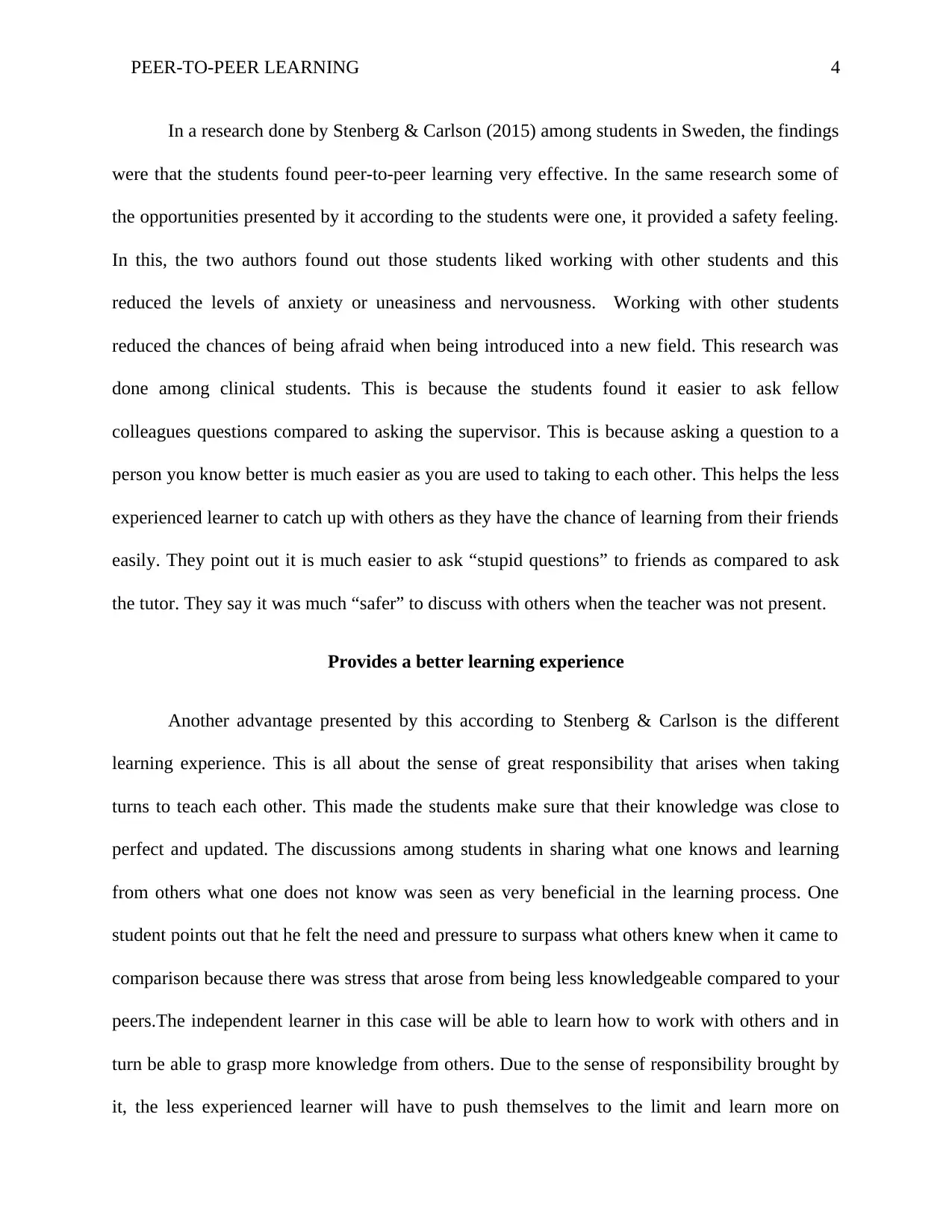
PEER-TO-PEER LEARNING 4
In a research done by Stenberg & Carlson (2015) among students in Sweden, the findings
were that the students found peer-to-peer learning very effective. In the same research some of
the opportunities presented by it according to the students were one, it provided a safety feeling.
In this, the two authors found out those students liked working with other students and this
reduced the levels of anxiety or uneasiness and nervousness. Working with other students
reduced the chances of being afraid when being introduced into a new field. This research was
done among clinical students. This is because the students found it easier to ask fellow
colleagues questions compared to asking the supervisor. This is because asking a question to a
person you know better is much easier as you are used to taking to each other. This helps the less
experienced learner to catch up with others as they have the chance of learning from their friends
easily. They point out it is much easier to ask “stupid questions” to friends as compared to ask
the tutor. They say it was much “safer” to discuss with others when the teacher was not present.
Provides a better learning experience
Another advantage presented by this according to Stenberg & Carlson is the different
learning experience. This is all about the sense of great responsibility that arises when taking
turns to teach each other. This made the students make sure that their knowledge was close to
perfect and updated. The discussions among students in sharing what one knows and learning
from others what one does not know was seen as very beneficial in the learning process. One
student points out that he felt the need and pressure to surpass what others knew when it came to
comparison because there was stress that arose from being less knowledgeable compared to your
peers.The independent learner in this case will be able to learn how to work with others and in
turn be able to grasp more knowledge from others. Due to the sense of responsibility brought by
it, the less experienced learner will have to push themselves to the limit and learn more on
In a research done by Stenberg & Carlson (2015) among students in Sweden, the findings
were that the students found peer-to-peer learning very effective. In the same research some of
the opportunities presented by it according to the students were one, it provided a safety feeling.
In this, the two authors found out those students liked working with other students and this
reduced the levels of anxiety or uneasiness and nervousness. Working with other students
reduced the chances of being afraid when being introduced into a new field. This research was
done among clinical students. This is because the students found it easier to ask fellow
colleagues questions compared to asking the supervisor. This is because asking a question to a
person you know better is much easier as you are used to taking to each other. This helps the less
experienced learner to catch up with others as they have the chance of learning from their friends
easily. They point out it is much easier to ask “stupid questions” to friends as compared to ask
the tutor. They say it was much “safer” to discuss with others when the teacher was not present.
Provides a better learning experience
Another advantage presented by this according to Stenberg & Carlson is the different
learning experience. This is all about the sense of great responsibility that arises when taking
turns to teach each other. This made the students make sure that their knowledge was close to
perfect and updated. The discussions among students in sharing what one knows and learning
from others what one does not know was seen as very beneficial in the learning process. One
student points out that he felt the need and pressure to surpass what others knew when it came to
comparison because there was stress that arose from being less knowledgeable compared to your
peers.The independent learner in this case will be able to learn how to work with others and in
turn be able to grasp more knowledge from others. Due to the sense of responsibility brought by
it, the less experienced learner will have to push themselves to the limit and learn more on
Paraphrase This Document
Need a fresh take? Get an instant paraphrase of this document with our AI Paraphraser
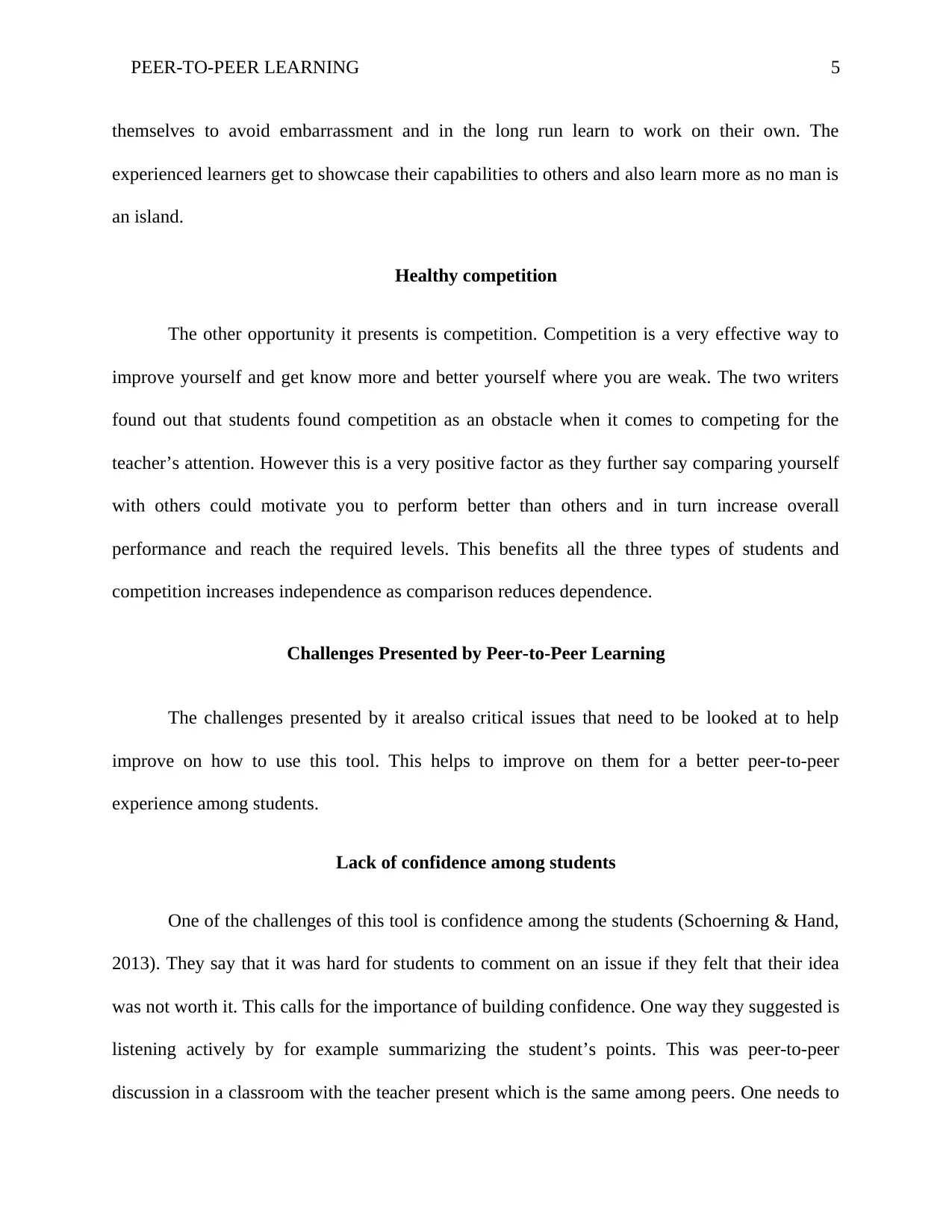
PEER-TO-PEER LEARNING 5
themselves to avoid embarrassment and in the long run learn to work on their own. The
experienced learners get to showcase their capabilities to others and also learn more as no man is
an island.
Healthy competition
The other opportunity it presents is competition. Competition is a very effective way to
improve yourself and get know more and better yourself where you are weak. The two writers
found out that students found competition as an obstacle when it comes to competing for the
teacher’s attention. However this is a very positive factor as they further say comparing yourself
with others could motivate you to perform better than others and in turn increase overall
performance and reach the required levels. This benefits all the three types of students and
competition increases independence as comparison reduces dependence.
Challenges Presented by Peer-to-Peer Learning
The challenges presented by it arealso critical issues that need to be looked at to help
improve on how to use this tool. This helps to improve on them for a better peer-to-peer
experience among students.
Lack of confidence among students
One of the challenges of this tool is confidence among the students (Schoerning & Hand,
2013). They say that it was hard for students to comment on an issue if they felt that their idea
was not worth it. This calls for the importance of building confidence. One way they suggested is
listening actively by for example summarizing the student’s points. This was peer-to-peer
discussion in a classroom with the teacher present which is the same among peers. One needs to
themselves to avoid embarrassment and in the long run learn to work on their own. The
experienced learners get to showcase their capabilities to others and also learn more as no man is
an island.
Healthy competition
The other opportunity it presents is competition. Competition is a very effective way to
improve yourself and get know more and better yourself where you are weak. The two writers
found out that students found competition as an obstacle when it comes to competing for the
teacher’s attention. However this is a very positive factor as they further say comparing yourself
with others could motivate you to perform better than others and in turn increase overall
performance and reach the required levels. This benefits all the three types of students and
competition increases independence as comparison reduces dependence.
Challenges Presented by Peer-to-Peer Learning
The challenges presented by it arealso critical issues that need to be looked at to help
improve on how to use this tool. This helps to improve on them for a better peer-to-peer
experience among students.
Lack of confidence among students
One of the challenges of this tool is confidence among the students (Schoerning & Hand,
2013). They say that it was hard for students to comment on an issue if they felt that their idea
was not worth it. This calls for the importance of building confidence. One way they suggested is
listening actively by for example summarizing the student’s points. This was peer-to-peer
discussion in a classroom with the teacher present which is the same among peers. One needs to
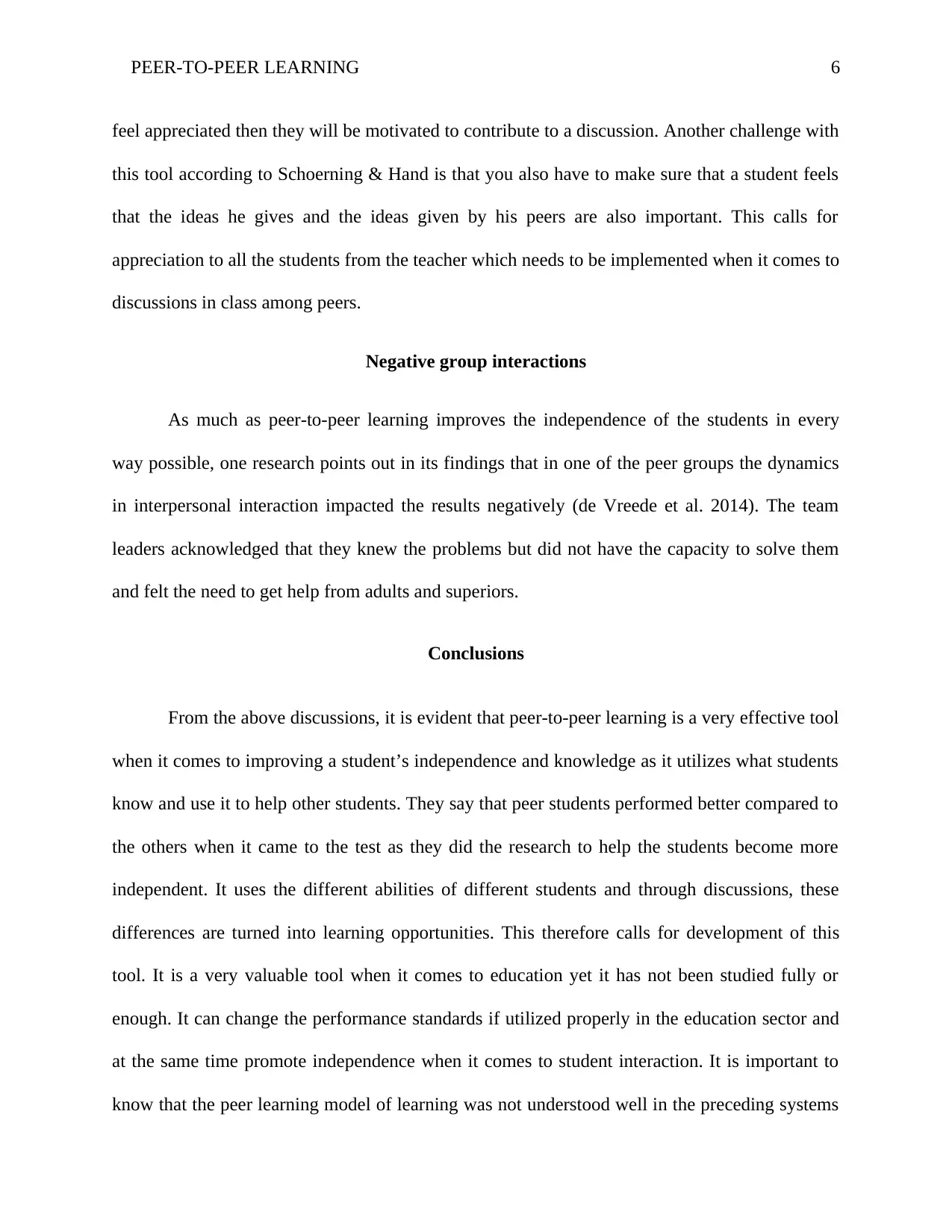
PEER-TO-PEER LEARNING 6
feel appreciated then they will be motivated to contribute to a discussion. Another challenge with
this tool according to Schoerning & Hand is that you also have to make sure that a student feels
that the ideas he gives and the ideas given by his peers are also important. This calls for
appreciation to all the students from the teacher which needs to be implemented when it comes to
discussions in class among peers.
Negative group interactions
As much as peer-to-peer learning improves the independence of the students in every
way possible, one research points out in its findings that in one of the peer groups the dynamics
in interpersonal interaction impacted the results negatively (de Vreede et al. 2014). The team
leaders acknowledged that they knew the problems but did not have the capacity to solve them
and felt the need to get help from adults and superiors.
Conclusions
From the above discussions, it is evident that peer-to-peer learning is a very effective tool
when it comes to improving a student’s independence and knowledge as it utilizes what students
know and use it to help other students. They say that peer students performed better compared to
the others when it came to the test as they did the research to help the students become more
independent. It uses the different abilities of different students and through discussions, these
differences are turned into learning opportunities. This therefore calls for development of this
tool. It is a very valuable tool when it comes to education yet it has not been studied fully or
enough. It can change the performance standards if utilized properly in the education sector and
at the same time promote independence when it comes to student interaction. It is important to
know that the peer learning model of learning was not understood well in the preceding systems
feel appreciated then they will be motivated to contribute to a discussion. Another challenge with
this tool according to Schoerning & Hand is that you also have to make sure that a student feels
that the ideas he gives and the ideas given by his peers are also important. This calls for
appreciation to all the students from the teacher which needs to be implemented when it comes to
discussions in class among peers.
Negative group interactions
As much as peer-to-peer learning improves the independence of the students in every
way possible, one research points out in its findings that in one of the peer groups the dynamics
in interpersonal interaction impacted the results negatively (de Vreede et al. 2014). The team
leaders acknowledged that they knew the problems but did not have the capacity to solve them
and felt the need to get help from adults and superiors.
Conclusions
From the above discussions, it is evident that peer-to-peer learning is a very effective tool
when it comes to improving a student’s independence and knowledge as it utilizes what students
know and use it to help other students. They say that peer students performed better compared to
the others when it came to the test as they did the research to help the students become more
independent. It uses the different abilities of different students and through discussions, these
differences are turned into learning opportunities. This therefore calls for development of this
tool. It is a very valuable tool when it comes to education yet it has not been studied fully or
enough. It can change the performance standards if utilized properly in the education sector and
at the same time promote independence when it comes to student interaction. It is important to
know that the peer learning model of learning was not understood well in the preceding systems
⊘ This is a preview!⊘
Do you want full access?
Subscribe today to unlock all pages.

Trusted by 1+ million students worldwide
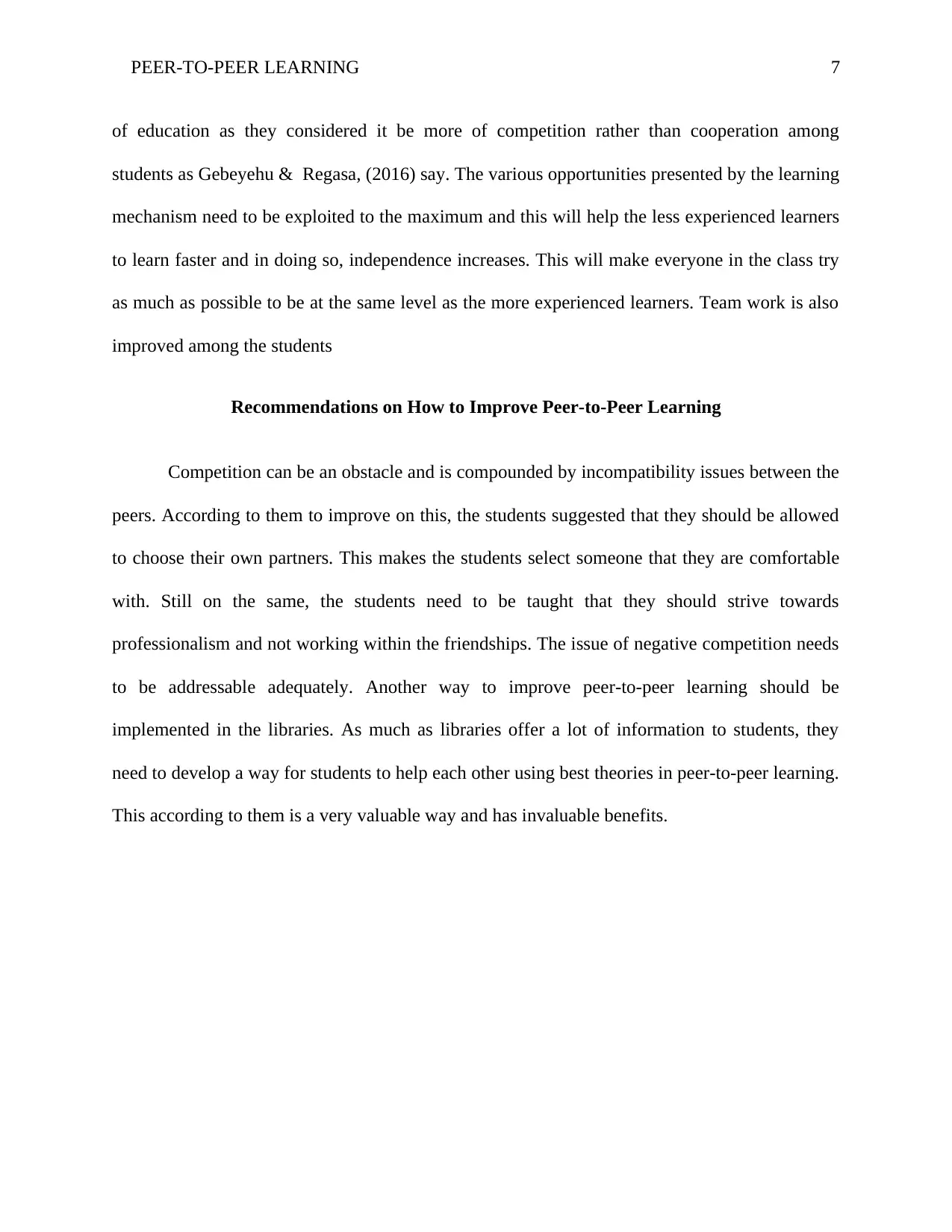
PEER-TO-PEER LEARNING 7
of education as they considered it be more of competition rather than cooperation among
students as Gebeyehu & Regasa, (2016) say. The various opportunities presented by the learning
mechanism need to be exploited to the maximum and this will help the less experienced learners
to learn faster and in doing so, independence increases. This will make everyone in the class try
as much as possible to be at the same level as the more experienced learners. Team work is also
improved among the students
Recommendations on How to Improve Peer-to-Peer Learning
Competition can be an obstacle and is compounded by incompatibility issues between the
peers. According to them to improve on this, the students suggested that they should be allowed
to choose their own partners. This makes the students select someone that they are comfortable
with. Still on the same, the students need to be taught that they should strive towards
professionalism and not working within the friendships. The issue of negative competition needs
to be addressable adequately. Another way to improve peer-to-peer learning should be
implemented in the libraries. As much as libraries offer a lot of information to students, they
need to develop a way for students to help each other using best theories in peer-to-peer learning.
This according to them is a very valuable way and has invaluable benefits.
of education as they considered it be more of competition rather than cooperation among
students as Gebeyehu & Regasa, (2016) say. The various opportunities presented by the learning
mechanism need to be exploited to the maximum and this will help the less experienced learners
to learn faster and in doing so, independence increases. This will make everyone in the class try
as much as possible to be at the same level as the more experienced learners. Team work is also
improved among the students
Recommendations on How to Improve Peer-to-Peer Learning
Competition can be an obstacle and is compounded by incompatibility issues between the
peers. According to them to improve on this, the students suggested that they should be allowed
to choose their own partners. This makes the students select someone that they are comfortable
with. Still on the same, the students need to be taught that they should strive towards
professionalism and not working within the friendships. The issue of negative competition needs
to be addressable adequately. Another way to improve peer-to-peer learning should be
implemented in the libraries. As much as libraries offer a lot of information to students, they
need to develop a way for students to help each other using best theories in peer-to-peer learning.
This according to them is a very valuable way and has invaluable benefits.
Paraphrase This Document
Need a fresh take? Get an instant paraphrase of this document with our AI Paraphraser
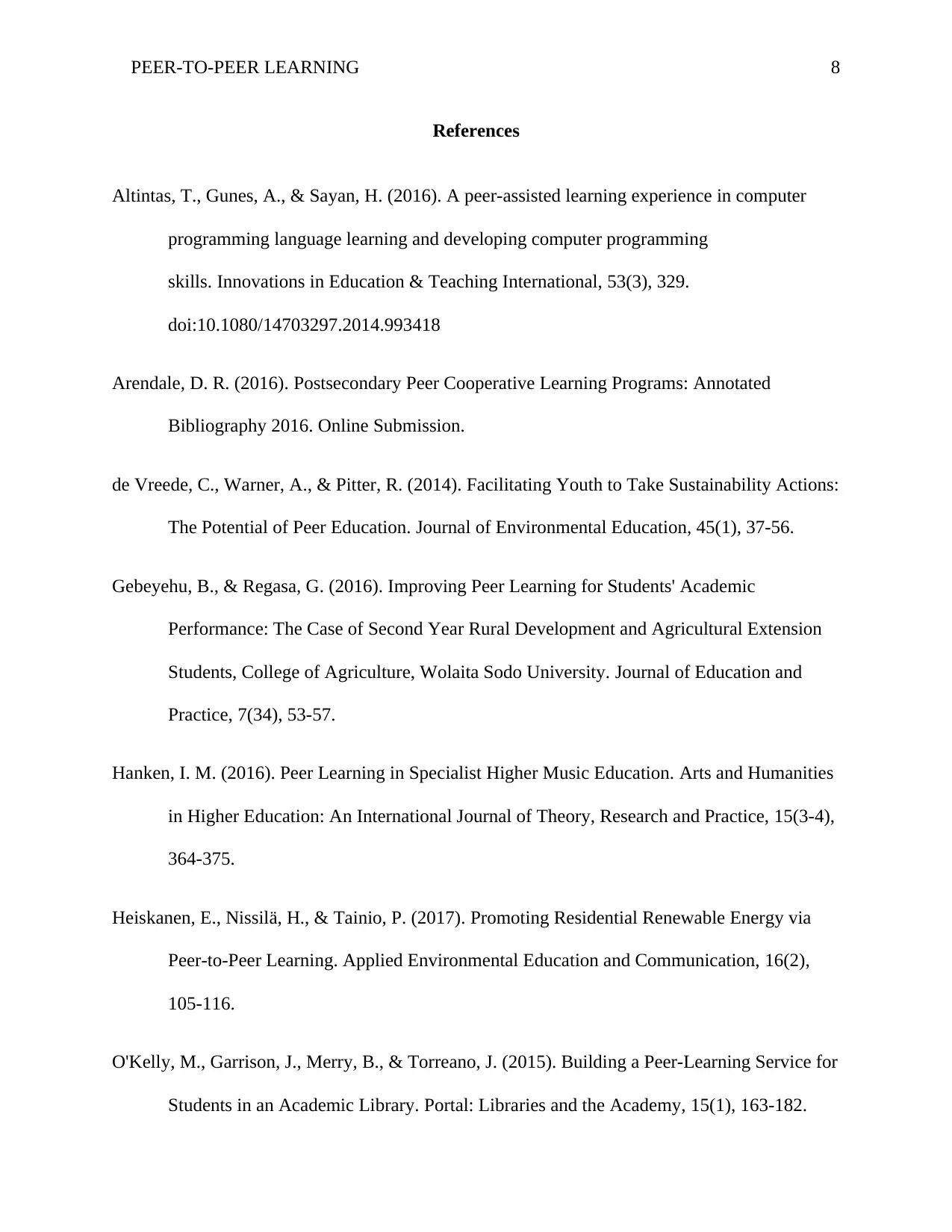
PEER-TO-PEER LEARNING 8
References
Altintas, T., Gunes, A., & Sayan, H. (2016). A peer-assisted learning experience in computer
programming language learning and developing computer programming
skills. Innovations in Education & Teaching International, 53(3), 329.
doi:10.1080/14703297.2014.993418
Arendale, D. R. (2016). Postsecondary Peer Cooperative Learning Programs: Annotated
Bibliography 2016. Online Submission.
de Vreede, C., Warner, A., & Pitter, R. (2014). Facilitating Youth to Take Sustainability Actions:
The Potential of Peer Education. Journal of Environmental Education, 45(1), 37-56.
Gebeyehu, B., & Regasa, G. (2016). Improving Peer Learning for Students' Academic
Performance: The Case of Second Year Rural Development and Agricultural Extension
Students, College of Agriculture, Wolaita Sodo University. Journal of Education and
Practice, 7(34), 53-57.
Hanken, I. M. (2016). Peer Learning in Specialist Higher Music Education. Arts and Humanities
in Higher Education: An International Journal of Theory, Research and Practice, 15(3-4),
364-375.
Heiskanen, E., Nissilä, H., & Tainio, P. (2017). Promoting Residential Renewable Energy via
Peer-to-Peer Learning. Applied Environmental Education and Communication, 16(2),
105-116.
O'Kelly, M., Garrison, J., Merry, B., & Torreano, J. (2015). Building a Peer-Learning Service for
Students in an Academic Library. Portal: Libraries and the Academy, 15(1), 163-182.
References
Altintas, T., Gunes, A., & Sayan, H. (2016). A peer-assisted learning experience in computer
programming language learning and developing computer programming
skills. Innovations in Education & Teaching International, 53(3), 329.
doi:10.1080/14703297.2014.993418
Arendale, D. R. (2016). Postsecondary Peer Cooperative Learning Programs: Annotated
Bibliography 2016. Online Submission.
de Vreede, C., Warner, A., & Pitter, R. (2014). Facilitating Youth to Take Sustainability Actions:
The Potential of Peer Education. Journal of Environmental Education, 45(1), 37-56.
Gebeyehu, B., & Regasa, G. (2016). Improving Peer Learning for Students' Academic
Performance: The Case of Second Year Rural Development and Agricultural Extension
Students, College of Agriculture, Wolaita Sodo University. Journal of Education and
Practice, 7(34), 53-57.
Hanken, I. M. (2016). Peer Learning in Specialist Higher Music Education. Arts and Humanities
in Higher Education: An International Journal of Theory, Research and Practice, 15(3-4),
364-375.
Heiskanen, E., Nissilä, H., & Tainio, P. (2017). Promoting Residential Renewable Energy via
Peer-to-Peer Learning. Applied Environmental Education and Communication, 16(2),
105-116.
O'Kelly, M., Garrison, J., Merry, B., & Torreano, J. (2015). Building a Peer-Learning Service for
Students in an Academic Library. Portal: Libraries and the Academy, 15(1), 163-182.
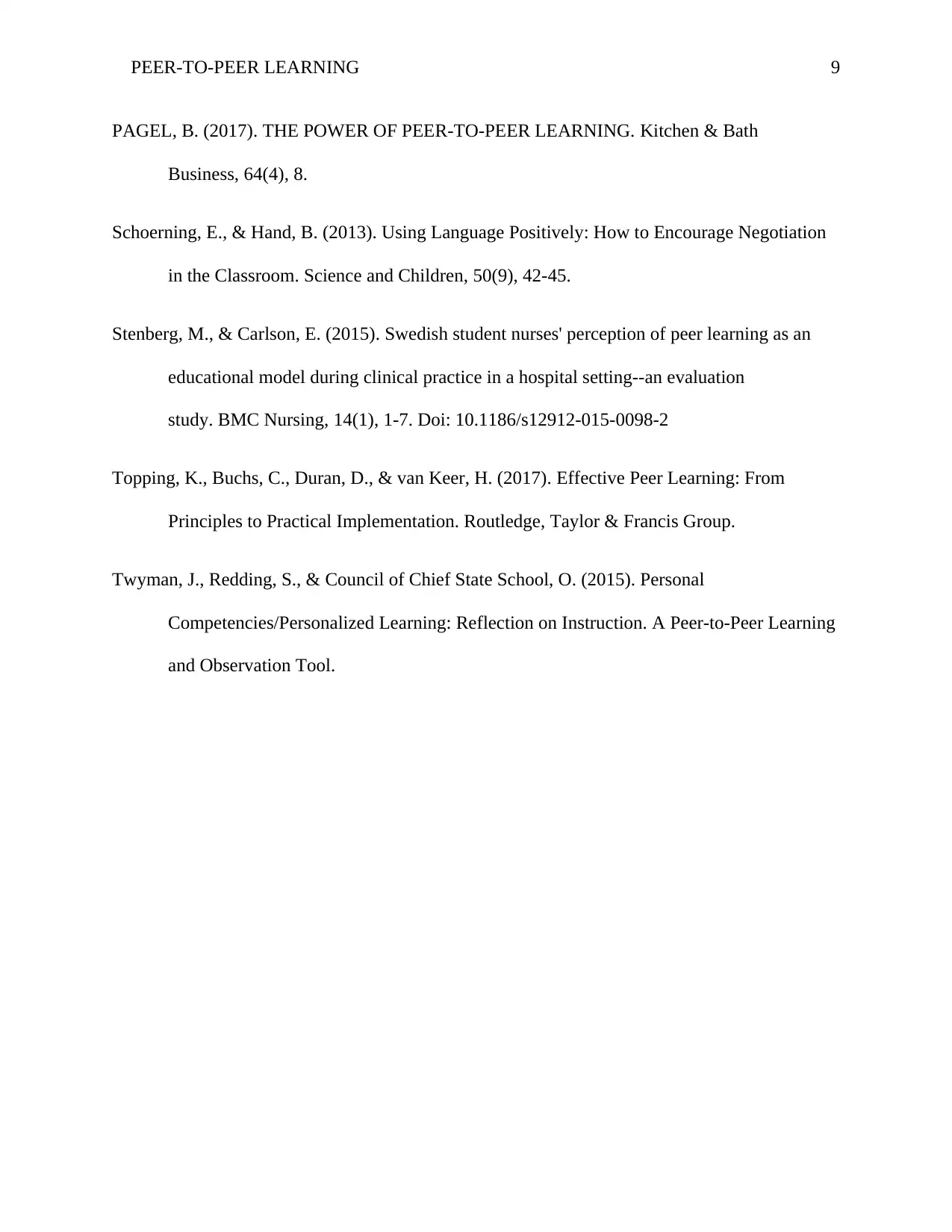
PEER-TO-PEER LEARNING 9
PAGEL, B. (2017). THE POWER OF PEER-TO-PEER LEARNING. Kitchen & Bath
Business, 64(4), 8.
Schoerning, E., & Hand, B. (2013). Using Language Positively: How to Encourage Negotiation
in the Classroom. Science and Children, 50(9), 42-45.
Stenberg, M., & Carlson, E. (2015). Swedish student nurses' perception of peer learning as an
educational model during clinical practice in a hospital setting--an evaluation
study. BMC Nursing, 14(1), 1-7. Doi: 10.1186/s12912-015-0098-2
Topping, K., Buchs, C., Duran, D., & van Keer, H. (2017). Effective Peer Learning: From
Principles to Practical Implementation. Routledge, Taylor & Francis Group.
Twyman, J., Redding, S., & Council of Chief State School, O. (2015). Personal
Competencies/Personalized Learning: Reflection on Instruction. A Peer-to-Peer Learning
and Observation Tool.
PAGEL, B. (2017). THE POWER OF PEER-TO-PEER LEARNING. Kitchen & Bath
Business, 64(4), 8.
Schoerning, E., & Hand, B. (2013). Using Language Positively: How to Encourage Negotiation
in the Classroom. Science and Children, 50(9), 42-45.
Stenberg, M., & Carlson, E. (2015). Swedish student nurses' perception of peer learning as an
educational model during clinical practice in a hospital setting--an evaluation
study. BMC Nursing, 14(1), 1-7. Doi: 10.1186/s12912-015-0098-2
Topping, K., Buchs, C., Duran, D., & van Keer, H. (2017). Effective Peer Learning: From
Principles to Practical Implementation. Routledge, Taylor & Francis Group.
Twyman, J., Redding, S., & Council of Chief State School, O. (2015). Personal
Competencies/Personalized Learning: Reflection on Instruction. A Peer-to-Peer Learning
and Observation Tool.
⊘ This is a preview!⊘
Do you want full access?
Subscribe today to unlock all pages.

Trusted by 1+ million students worldwide
1 out of 9
Related Documents
Your All-in-One AI-Powered Toolkit for Academic Success.
+13062052269
info@desklib.com
Available 24*7 on WhatsApp / Email
![[object Object]](/_next/static/media/star-bottom.7253800d.svg)
Unlock your academic potential
Copyright © 2020–2025 A2Z Services. All Rights Reserved. Developed and managed by ZUCOL.





